A Babysitting emergency flyers address the challenge parents face in finding immediate childcare during crises by positioning providers as fast, reliable solutions. They work best when placed in high-traffic, crisis-relevant locations like hospital waiting rooms, pediatric clinics, and corporate building lobbies places where stressed parents are most likely to seek urgent help. Highlighting 24/7 availability, rapid response times, and verified safety credentials builds instant trust and increases the likelihood of securing emergency bookings. Using ready-made flyer templates can make it easier for providers to deliver a professional design quickly in such situations.
Effective designs use bold, urgency-themed visuals, large and clear contact information, and visible trust indicators such as certifications. Strategic timing is equally important distribute flyers during periods when same-day childcare demand spikes. Providers looking for more customization can also create a flyer from scratch to match specific messaging with community needs. By combining targeted placement, urgent messaging, and professional credibility, babysitting emergency flyers can convert crisis situations into high-value, immediate bookings.
How Can Babysitting Emergency Flyers Help Providers Capture Same-day Booking Opportunities?
Babysitting emergency flyers serve as immediate marketing tools that position providers at the forefront when childcare crises strike. “With approximately 61% of parents reporting no formal childcare arrangements and around 15% of unemployed parents citing childcare needs as the reason for not working, emergency situations create significant demand for immediate childcare solutions.1” By strategically distributing these flyers in high-traffic family areas, providers create instant visibility during peak demand periods. Emergency flyers showcase rapid response capabilities, extended availability, and crisis-ready services that desperate parents actively seek. Unlike online listings that require searching, physical flyers provide immediate contact information when parents face unexpected childcare emergencies. This proactive distribution strategy transforms providers from hidden services into accessible solutions, directly connecting them with lucrative same-day booking opportunities that competitors miss.

Strategic Distribution Points That Maximize Emergency Booking Visibility
Target high-stress locations where parents experiencing childcare crises naturally gravitate. Hospital emergency departments and urgent care centers catch parents during medical emergencies requiring immediate childcare solutions. Pediatrician offices and pharmacy bulletin boards provide visibility when parents handle sick children while managing work obligations. Corporate office building lobbies reach working parents facing unexpected overtime or travel demands, and considering placement strategies from a babysitting flyer distribution guide can help make flyers more visible in these areas.
Coffee shops near medical facilities capture parents during crisis management periods. Daycare center entrances and school pickup areas offer prime visibility during regular parent routines. Community centers and grocery store customer service desks provide consistent exposure to family-focused demographics.
Position flyers at eye level in areas where parents wait or gather information. Refresh placement weekly to maintain visibility and ensure current contact information remains accessible during critical moments when parents need immediate childcare assistance.
Time-Sensitive Design Elements That Trigger Immediate Parent Response
Bold emergency colors like red or orange capture attention instantly during stressful situations. Large, readable fonts ensure contact information remains visible to stressed parents scanning quickly for solutions. Prominent “24/7 AVAILABLE” or “15-MINUTE RESPONSE” messaging communicates immediate availability without requiring detailed reading.
Visual hierarchy places phone numbers prominently, with secondary contact methods like texting clearly displayed. Emergency symbols and phone graphics provide instant recognition of available services. Clear availability windows distinguish emergency providers from standard babysitters through visual differentiation, “addressing the critical need highlighted by research showing that mothers of young children experienced the steepest employment declines during childcare disruptions.2“
White space prevents clutter while ensuring critical information stands out during rapid scanning. Color-coded sections separate emergency services from regular rates, helping parents quickly identify crisis-specific offerings. Oversized contact details accommodate parents who may be driving or handling multiple stressors simultaneously while seeking immediate childcare solutions.
Converting Crisis Moments Into High-Value Same-Day Bookings
Transform emergency inquiries into premium bookings through structured response protocols. Answer calls within two rings during posted emergency hours, immediately confirming availability and response timeframes. Quote emergency rates upfront to qualify serious inquiries and justify premium pricing for immediate service availability.
Streamline booking processes by collecting essential information quickly: location, timeline, number of children, and specific emergency circumstances. This efficiency demonstrates professionalism while enabling rapid deployment to crisis situations. Maintain backup provider networks for overflow capacity during peak emergency periods.
Emergency situations often involve extended hours, overnight care, or specialized circumstances like sick child supervision. These scenarios command premium rates while building long-term client relationships through reliable crisis support. Parents who receive excellent emergency service become repeat customers and referral sources for future opportunities.
Track emergency call patterns to identify peak crisis periods and adjust availability accordingly. Hospital shift changes, severe weather events, and school closure announcements create predictable demand surges. Proactive communication during these periods through text updates and social media announcements captures additional same-day opportunities while positioning providers as dependable emergency childcare specialists who understand urgent family needs.
What Essential Information Should Babysitting Emergency Flyers Include For Rapid Response Services?
Effective babysitting emergency flyers must prioritize critical information that enables instant decision-making during childcare crises. Essential elements include prominent contact details, specific availability windows, emergency response timeframes, and safety credentials. Parents in crisis need immediate confirmation of provider reliability, so including background check status, CPR certification, and emergency procedure training builds instant trust. Babysitting safety information flyers should feature age-specific care capabilities, transportation availability, and flexible scheduling options. Clear pricing structures for emergency services eliminate hesitation, and using tips for creating cost-effective babysitting flyers can help new sitters structure information efficiently while keeping printing and distribution affordable. Multiple contact methods ensure parents can reach providers regardless of circumstances, converting urgent needs into immediate bookings.

Critical Contact Information Architecture for Crisis Communication
Emergency contact architecture demands multiple communication channels for instant provider-parent connection. Primary phone numbers with voicemail backup ensure accessibility during peak demand periods. Text messaging capabilities provide quick screening options when voice calls overwhelm providers. Email addresses serve secondary confirmation roles while dedicated emergency hotlines separate crisis bookings from routine inquiries.
Contact information hierarchy places mobile numbers prominently, followed by text-enabled lines for rapid response coordination. Backup contact systems prevent missed opportunities during simultaneous emergency requests. Response time guarantees like “15-minute callback” or “immediate text confirmation” differentiate professional emergency services from standard babysitting providers.
Strategic placement positions contact details in upper sections using bold typography and contrasting colors. Multiple contact method displays accommodate parent communication preferences during stressful situations when quick provider connection determines booking success.
Trust-Building Credentials That Accelerate Emergency Hiring Decisions
Safety credentials provide immediate trust validation during crisis decision-making when parents lack time for extensive vetting processes. Background check certifications with visible completion dates reassure parents about provider screening. CPR and first aid certifications demonstrate emergency medical preparedness essential for childcare crisis situations. Incorporating insights from babysitting trust flyer recovery tips can further show how to highlight these credentials effectively to build parent confidence.
Professional liability insurance coverage details protect families while showcasing provider legitimacy. Years of emergency childcare experience quantify crisis management capabilities. Pediatric emergency training certificates indicate specialized preparation for medical situations involving children.
Reference contact information from previous emergency clients provides verification options for concerned parents. Professional associations or childcare organization memberships demonstrate industry commitment and ongoing education requirements.
- Trusted Babysitting Services Advertisement Flyer Template
- Trusted Babysitting Services Promotional Flyer Template
Availability Indicators That Match Parent Emergency Timeframes
Availability communication requires specific timeframe commitments matching parent emergency needs. “24/7 emergency response,” “same-day availability,” and “2-hour notice acceptance” directly address urgent childcare requirements. Weekend and holiday availability specifications target peak emergency demand periods.
Age-specific care capabilities help parents quickly identify suitable providers for their children’s needs. “Infant care specialist,” “special needs experience,” or “multiple children capable” accelerate provider-family matching during time-sensitive situations.
Transportation availability for school pickups, medical appointments, or emergency situations expands service value during complex childcare crises. Overnight care capabilities address extended emergency coverage needs when parents face hospitalization or extended work emergencies.
Flexible scheduling accommodation statements like “last-minute booking accepted” or “emergency rate adjustments available” demonstrate provider understanding of crisis situations requiring immediate solutions.
Clear emergency service pricing eliminates cost uncertainty during decision-making, while “immediate booking confirmation” messaging provides parents confidence in securing required childcare coverage during unexpected situations.
- Professional Babysitter Service Promotion Flyer Template
- Professional Babysitting Services Offer Flyer Template
Where Should Emergency Babysitters Distribute Their Flyers For Maximum Crisis-situation Visibility?
Strategic placement of babysitting emergency flyers in high-traffic crisis locations maximizes visibility when parents desperately need immediate childcare solutions. Emergency babysitters should target medical facilities, corporate buildings, and community hubs where stressed parents actively seek urgent assistance. Effective distribution focuses on locations where childcare emergencies commonly occur, positioning flyers where parents experience peak stress and time constraints requiring rapid response capabilities.
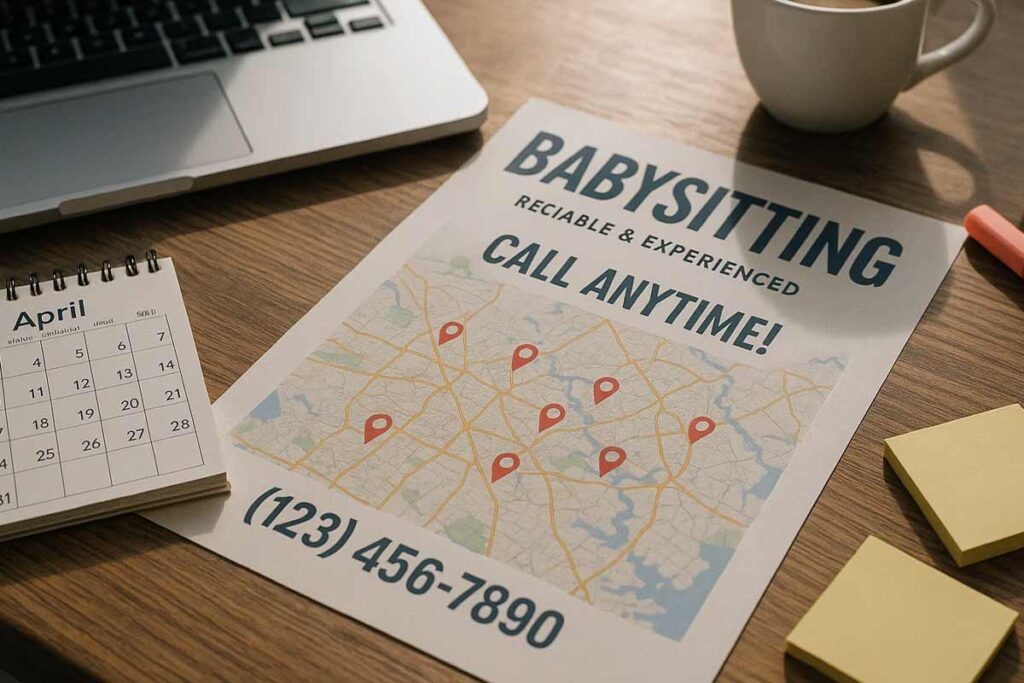
Medical Facility Partnerships for Crisis-Period Flyer Placement
Hospital emergency departments, urgent care centers, and pediatric offices represent prime distribution locations for babysitting emergency contact flyers. Parents visiting these facilities often face unexpected medical emergencies requiring immediate childcare for siblings or extended care during procedures. Target waiting rooms, customer service desks, and discharge areas where parents have time to notice emergency services.
Pharmacy bulletin boards and medical office reception areas provide consistent visibility to parents managing ongoing health situations. Partner with medical facility staff to maintain fresh flyers and ensure consistent placement. Include specific response time commitments like “Available within 2 hours for medical emergencies” to address urgent needs. Display babysitting safety information flyers prominently near pediatric areas where parents frequently worry about leaving sick children. Focus on facilities serving families rather than specialized adult-only practices for maximum emergency booking potential.
Corporate Building Distribution During Peak Emergency Hours
Office building lobbies, elevator banks, and employee break rooms capture working parents facing sudden childcare crises. Target morning hours (7-9 AM) and evening periods (5-7 PM) when parents juggle work demands with unexpected childcare needs. Corporate environments generate frequent emergency requests from business travel, overtime requirements, or school closures.
Position babysitting emergency procedure flyers near building directories, coffee stations, and mailroom areas where employees naturally pause. Include “Same-day corporate emergency response” messaging to attract high-value clients willing to pay premium rates. Business districts with law firms, consulting companies, and healthcare organizations generate consistent emergency demand.
Coordinate with building management for approved posting areas and refresh flyers weekly in high-traffic locations. Target buildings with 200+ employees for optimal visibility and emergency booking opportunities.
Community Hub Strategies for Maximum Parent Reach
Community centers, libraries, and grocery stores provide excellent visibility to diverse parent populations experiencing various emergency situations. These locations offer sustained foot traffic throughout the day, capturing parents during routine activities when emergencies arise unexpectedly.
School pickup areas and daycare entrances position flyers where parents already think about childcare logistics. Target Friday afternoons and Monday mornings when weekend or weekly planning occurs. Include babysitting emergency communication flyers local with neighborhood-specific contact methods and response areas.
Coffee shops near medical facilities, corporate districts, and family neighborhoods create multiple touchpoints for emergency visibility. Parents waiting for appointments or between errands notice well-placed emergency contact information during stress periods.
Digital distribution through neighborhood apps like Nextdoor amplifies physical flyer placement by reaching parents actively seeking immediate solutions. Post emergency availability updates during known crisis periods like snow days or flu outbreaks.
Strategic community placement combined with digital presence ensures maximum crisis-situation visibility when parents need immediate emergency babysitting solutions most.
- Community Center Babysitting Nights Flyer Template
- Local Babysitting Services Promotional Flyer Template
How Do Babysitting Emergency Flyers Differentiate Providers Offering Extended Hours And Rapid Response?
Babysitting emergency flyers must prominently showcase availability windows and response guarantees to distinguish rapid-response providers from standard childcare services. Effective differentiation relies on bold visual hierarchy that instantly communicates 24/7 availability, specific timeframe commitments, and specialized emergency credentials. Parents facing childcare crises need immediate confirmation of provider reliability, making visual design choices critical for capturing urgent bookings when seconds matter.
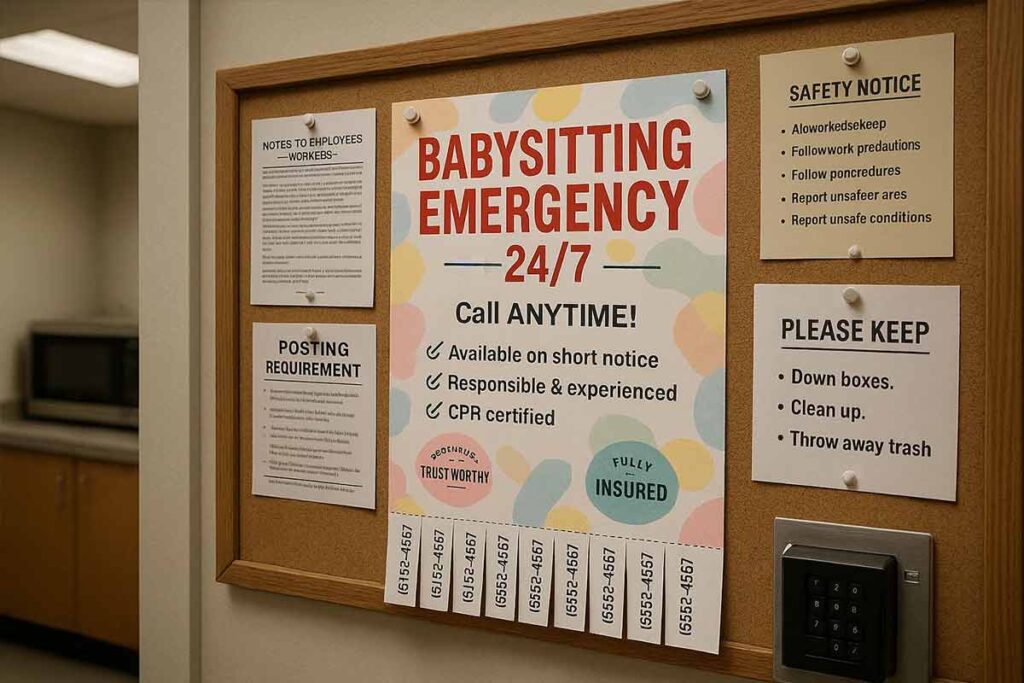
Visual Hierarchy Techniques for Emergency Service Differentiation
Strategic color coding separates emergency services from regular babysitting offerings through high-contrast design elements. Use emergency colors like red or orange for availability badges, contrasting against neutral backgrounds for maximum visibility. Position “24/7 EMERGENCY AVAILABLE” headers in oversized typography at the top third of flyers, ensuring parents identify rapid-response capabilities within seconds of viewing.
Create dedicated sections using bordered boxes or colored backgrounds to highlight extended hours versus standard availability. Emergency contact information requires premium placement with enlarged phone numbers and multiple contact methods displayed prominently. Visual hierarchy prioritizes response time commitments like “15-MINUTE CALLBACK GUARANTEED” above experience details or pricing information, addressing parents’ most urgent concerns first during crisis decision-making.
Certification Display Methods That Build Crisis-Moment Trust
Professional credentials build immediate confidence through strategic badge placement and verification elements. Display CPR certification logos, background check completion dates, and emergency medical training certificates in a dedicated trust section, typically positioned in the upper right corner for scanning efficiency. Include license numbers and certification expiration dates to demonstrate current qualifications.
Emergency-specific training certifications like pediatric first aid or crisis childcare management should receive prominent visual treatment through enlarged logos or highlighted text boxes. Trust indicators such as years of emergency childcare experience, number of crisis situations handled, and specialized training in sick child care differentiate providers from general babysitters. Insurance coverage details and bonding information provide additional reassurance for parents making rapid hiring decisions under stress.
Contact Information Optimization for Rapid Parent Response
Multiple communication channels maximize connection success during emergency situations when standard methods may fail. Primary phone numbers require bold formatting with accompanying text capability indicators, ensuring parents can reach providers regardless of circumstances. Include backup contact methods like secondary phones or instant messaging platforms for comprehensive accessibility.
Real-time availability indicators help parents identify immediately responsive providers through status updates or online scheduling links. Emergency hotline numbers should feature distinctive visual treatment, separated from regular booking contact information through color coding or bordered sections. Response time guarantees like “Answers within 3 rings” or “Immediate text response” provide specific expectations during urgent situations.
Digital contact integration through QR codes enables instant connection via smartphones, while traditional phone numbers accommodate various communication preferences. Include multiple contact scenarios such as “Call for immediate availability” or “Text for same-hour booking” to match different emergency urgency levels and parent communication styles.
What Design Elements Make Babysitting Emergency Flyers Stand Out During Childcare Crises?
Emergency-focused babysitting emergency flyers require strategic design elements that capture attention instantly during high-stress situations when parents need immediate childcare solutions. Bold color psychology, clear typography, and visual hierarchy create flyers that communicate urgent availability and trustworthiness. Effective emergency flyer design uses contrasting colors like bright red or orange backgrounds with white text, oversized contact information, and emergency-specific symbols. These elements help desperate parents quickly identify reliable providers offering rapid response capabilities, and understanding babysitting flyer design tips can further refine how these elements are applied in practice. Professional emergency flyer layouts feature prominent availability windows, certification badges, and multiple contact methods positioned for immediate visibility during crisis decision-making.
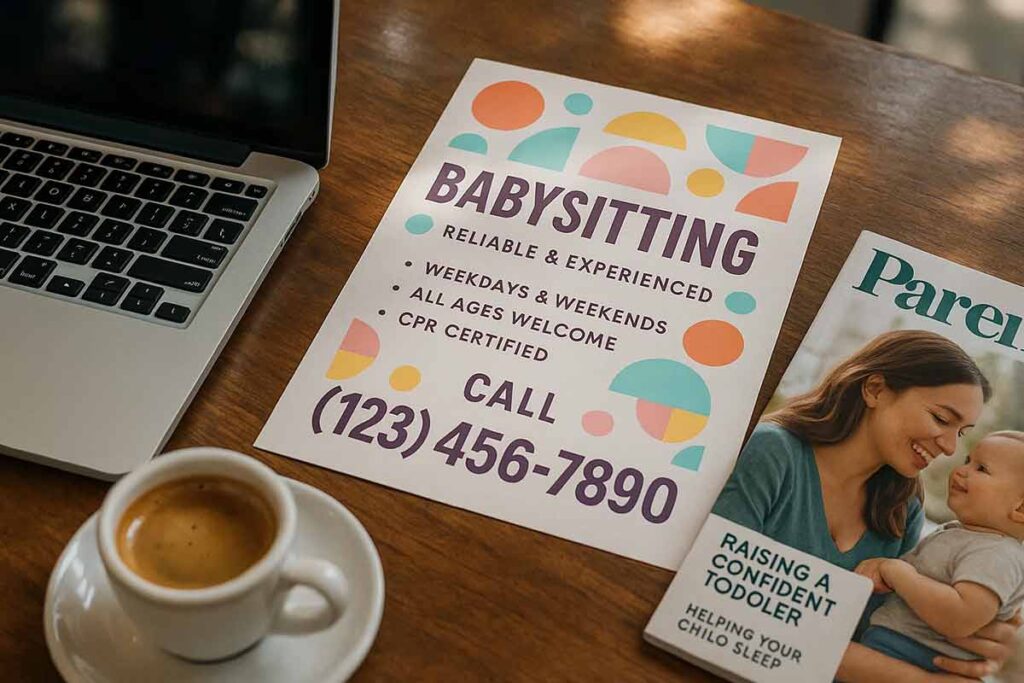
High-Impact Color Psychology for Crisis Communication
Emergency color schemes leverage psychological triggers that signal immediate assistance. Red backgrounds with white text create urgency and grab attention in cluttered environments like community bulletin boards or medical office waiting areas. Orange accents highlight critical information like phone numbers and availability windows, while maintaining professional credibility. High-contrast combinations ensure readability under fluorescent lighting conditions common in hospitals, daycares, and corporate buildings where stressed parents seek solutions.
Color-coded sections separate emergency services from regular babysitting offerings. Emergency availability uses red borders, while standard services use blue or green accents. This visual differentiation helps parents instantly identify providers capable of same-day response. Strategic color placement guides eye movement toward essential information like contact methods and response timeframes.
- Playful Colorful Babysitting Services Advertisement Flyer Template
- Playful Blue Denim Babysitting Services Flyer Template
- Modern Soft Purple Babysitting Services Flyer Template
Strategic Typography Choices That Ensure Readability Under Stress
Large, bold typography ensures critical information remains visible when parents experience decision-making pressure during childcare emergencies. Emergency contact numbers use minimum 24-point fonts, while availability windows require 18-point sizing for instant recognition. Sans-serif fonts like Arial or Helvetica provide maximum readability across different lighting conditions and viewing distances.
Hierarchical font sizing creates information priority systems. Primary contact numbers receive largest treatment, followed by availability hours, then qualifications and services. Bold weight distinguishes emergency-specific information from general babysitting details. Anyone designing their own materials can make the process easier with an editable babysitting flyer template, which comes pre-structured with typography best practices while allowing full customization.
Text spacing prevents information crowding that causes reading difficulties during stressful situations. Emergency flyers use increased line spacing and generous margins to reduce visual clutter. Key phrases like “24/7 AVAILABLE” or “EMERGENCY RESPONSE” appear in all-capital letters with contrasting backgrounds for maximum impact.
Visual Hierarchy Techniques for Instant Information Processing
Strategic information placement follows natural eye-movement patterns, positioning critical elements in the upper-left quadrant where readers typically begin scanning. Emergency contact information occupies prime real estate, followed by availability windows and response timeframes. Professional certifications and background check badges appear prominently but secondary to contact methods.
Visual elements like emergency symbols, phone icons, and urgency indicators create immediate recognition patterns. Clock graphics highlight rapid response commitments, while shield symbols communicate safety credentials. These visual cues help parents quickly assess provider capabilities without reading detailed text.
Bordered sections create distinct information zones preventing important details from blending together. Emergency availability receives distinct visual treatment through colored borders or background shading. White space strategically separates different service categories, allowing stressed parents to quickly locate relevant information.
Information grouping follows logical decision-making sequences. Contact methods appear first, followed by availability confirmation, then trust indicators like certifications and references. This structured approach reduces cognitive load during crisis situations when parents need immediate solutions rather than extensive research.
How Can Babysitting Emergency Flyers Communicate Trustworthiness For Urgent Childcare Needs?
Trustworthy babysitting emergency flyers establish credibility through professional presentation and verification elements that reassure parents during childcare crises. Include professional headshots, certifications, background check badges, and reference testimonials prominently. Display licensing numbers, CPR certification logos, and years of experience clearly. Use professional language that emphasizes safety protocols, emergency procedures knowledge, and reliable service history. Include verifiable contact methods like business phone numbers and social media profiles. Trust indicators such as insurance coverage, bonding information, and association memberships help parents feel confident making rapid hiring decisions during stressful emergency situations.
- Experienced Babysitting Service Advertisement Flyer Template
- Childcare Babysitting Service Advertising Flyer Template
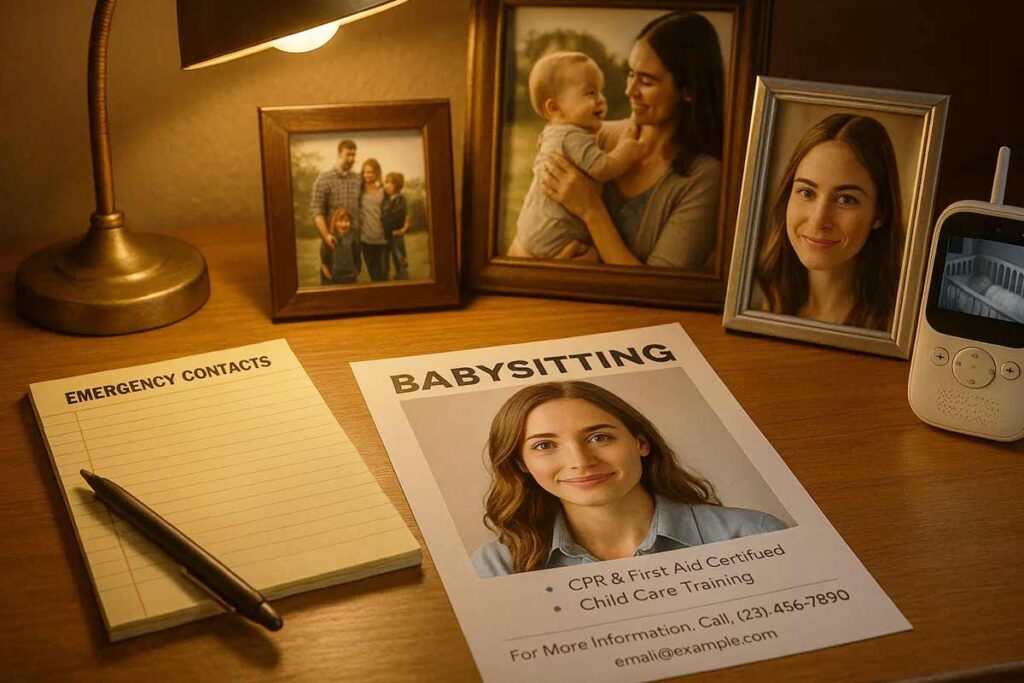
Credential Display Strategies That Build Immediate Confidence
Professional certifications provide instant credibility during crisis decision-making. Position CPR certification badges, first aid training certificates, and background check verification prominently in the top third of your babysitting emergency flyers. Include specific certification numbers and expiration dates to demonstrate current qualifications. List relevant training programs like infant safety courses, emergency response protocols, or pediatric care certifications. Display years of experience with age-specific care capabilities to address different family needs. Professional association memberships, such as local childcare organizations or babysitting services, add institutional credibility. Include any specialized training for children with special needs, allergy management, or medical emergency response. Avoid generic claims by providing specific, verifiable credentials that parents can research independently.
Professional Photography and Branding for Emergency Service Credibility
High-quality professional photos create immediate trust compared to casual smartphone images. Use clear headshots with professional lighting that convey approachability while maintaining professionalism. Include photos showing interaction with children in supervised settings to demonstrate comfort and competence. Consistent branding across all marketing materials reinforces professional reliability. Use professional fonts and color schemes that suggest trustworthiness rather than playful childish themes. Include your business logo or personal branding consistently throughout the flyer design. Professional presentation signals serious commitment to childcare rather than casual babysitting. Avoid overly casual clothing or unprofessional backgrounds in photos. Include multiple contact methods formatted professionally, such as business cards or branded contact information sections.
Verification Elements That Reassure Parents During Crisis Decisions
Reference testimonials from previous emergency situations provide powerful social proof when parents need immediate childcare solutions. Include specific scenarios like “Called Sarah at 11 PM when our child had a fever – she arrived within 30 minutes and handled everything perfectly.” Display actual parent quotes with first names and general locations for authenticity without compromising privacy. Include emergency contact references from pediatricians, schools, or other childcare professionals who can verify your reliability and competence. List insurance coverage details, including professional liability and bonding information that protects both families and providers. Provide links to online reviews, social media profiles, or professional websites where parents can verify credentials quickly. Include your business registration number or professional licensing information where applicable. Mention any criminal background check completion with specific dates to address parents’ primary safety concerns. Offer to provide additional references upon request, demonstrating transparency and confidence in your service history. Emergency contact protocols showing clear communication plans during childcare situations build additional trust during already stressful circumstances.
What Distribution Timing Maximizes Babysitting Emergency Flyers Effectiveness For Crisis Bookings?
Strategic distribution timing targets peak crisis periods when parents desperately need immediate childcare solutions. “Mothers with children under five disproportionately cite childcare problems as the main barrier to work, highlighting the critical need for accessible emergency childcare solutions.3” Deploy babysitting emergency flyers during weekday evenings (5-8 PM), weekend mornings, and school break periods when unexpected work demands surge. Pre-position flyers at pediatric offices, daycares, and community centers before anticipated high-demand windows like flu seasons or summer vacation starts. Emergency contact flyers distributed 24-48 hours before known stress periods capture parents proactively seeking backup options. Real-time digital distribution through neighborhood apps during active crisis situations yields highest conversion rates for same-day emergency bookings requiring rapid response capabilities.
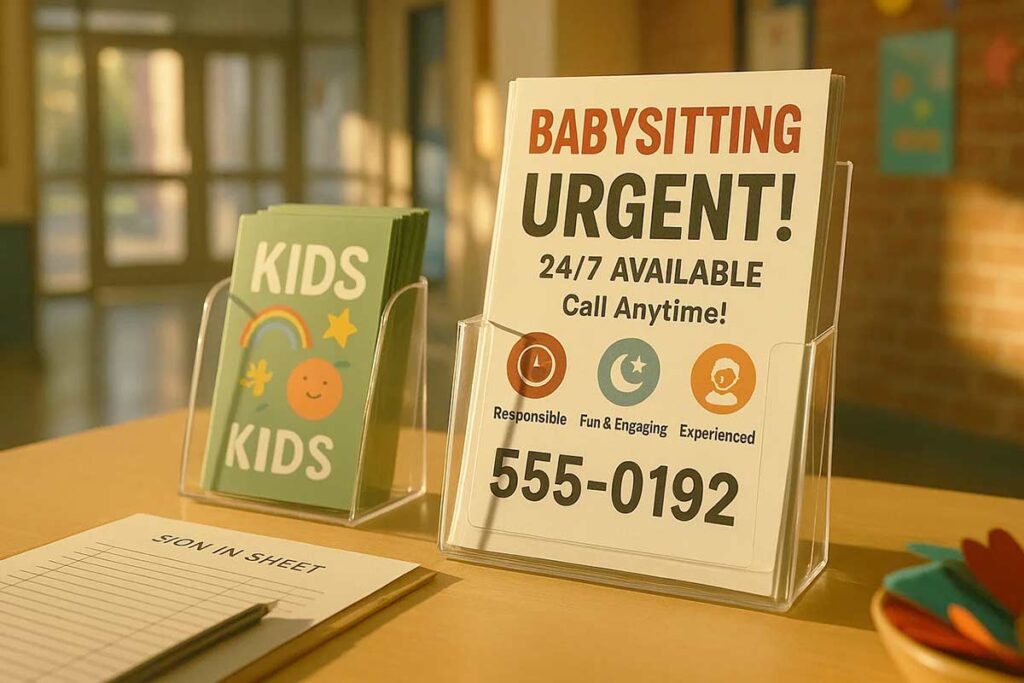
Peak Crisis Period Identification for Proactive Flyer Placement
Identify recurring crisis patterns to maximize babysitting emergency flyers visibility when parents need immediate solutions. School district sick days, weather-related closures, and parent work conference seasons create predictable childcare emergencies. Track local pediatric office peak illness periods, typically fall and winter months, positioning flyers before demand spikes. Monitor corporate calendar patterns including quarterly reporting periods, holiday events, and business travel seasons when professional parents require urgent childcare backup.
Influenza epidemics occur seasonally in winter across temperate climates, making this a predictable period for increased childcare emergencies.4
Deploy flyers strategically during back-to-school transitions, holiday work parties, and summer childcare gap periods. Babysitting safety information flyers placed before anticipated crisis windows capture parents seeking reliable emergency providers. Target distribution around major employer locations during high-stress work periods when overtime demands create sudden childcare needs.
Real-Time Digital Distribution During Active Emergency Situations
Digital platforms enable immediate distribution during active childcare crises when parents need urgent solutions. Post babysitting emergency contact flyers on neighborhood Facebook groups, Nextdoor community boards, and parent WhatsApp networks during school closure announcements or unexpected events. Real-time distribution through parent messaging apps reaches families actively searching for immediate childcare during weather emergencies, school lockdowns, or sudden work obligations.
Monitor local news and school district communications for emergency closure announcements, distributing flyers immediately when parents face unexpected childcare gaps. Babysitting emergency procedure flyers shared within minutes of crisis announcements capture desperate parents before competitors respond. Coordinate with parent networks to share emergency availability information during active situations requiring immediate childcare solutions.
Strategic Pre-Positioning at High-Traffic Parent Locations
Position babysitting emergency flyers at strategic locations parents visit during routine activities, ensuring visibility when crises develop. Target pediatric offices, school pickup areas, grocery stores, and coffee shops near daycares where parents gather regularly. Hospital waiting areas, urgent care centers, and pharmacy bulletin boards capture parents experiencing family emergencies requiring immediate childcare assistance.
Corporate office buildings, daycare centers, and community centers provide excellent exposure during peak parent traffic periods. Focus placement during school pickup times (3-4 PM), morning coffee runs (7-9 AM), and weekend family activity periods when parents are most likely to encounter flyers. Babysitting contact information flyers printable versions work best at locations where parents have time to review details thoroughly.
Refresh flyer placement every two weeks at high-traffic locations to maintain visibility and current contact information. Strategic positioning at parent-focused locations ensures babysitting emergency communication flyers local availability when unexpected childcare needs arise, creating immediate booking opportunities for qualified emergency providers.
How Should Babysitting Emergency Flyers Highlight 24/7 Availability And Immediate Response Capabilities?
Babysitting emergency flyers must prominently showcase round-the-clock availability through strategic visual hierarchy and urgent response messaging. Feature bold “24/7 EMERGENCY RESPONSE” headers with specific callback commitments like “30-minute response guarantee” or “2-hour arrival promise.” Use action-oriented language such as “Crisis Response Team” and “Emergency Childcare Hotline” to communicate immediate availability. Include dedicated emergency contact information separate from regular booking channels, with multiple communication methods including phone, text, and app-based systems. Visual elements like clock icons, emergency symbols, and high-contrast colors instantly communicate urgent availability during childcare crises.
- Reliable Babysitting Services Promotional Flyer Template
- Reliable Babysitting Services Advertisement A4 Flyer Template
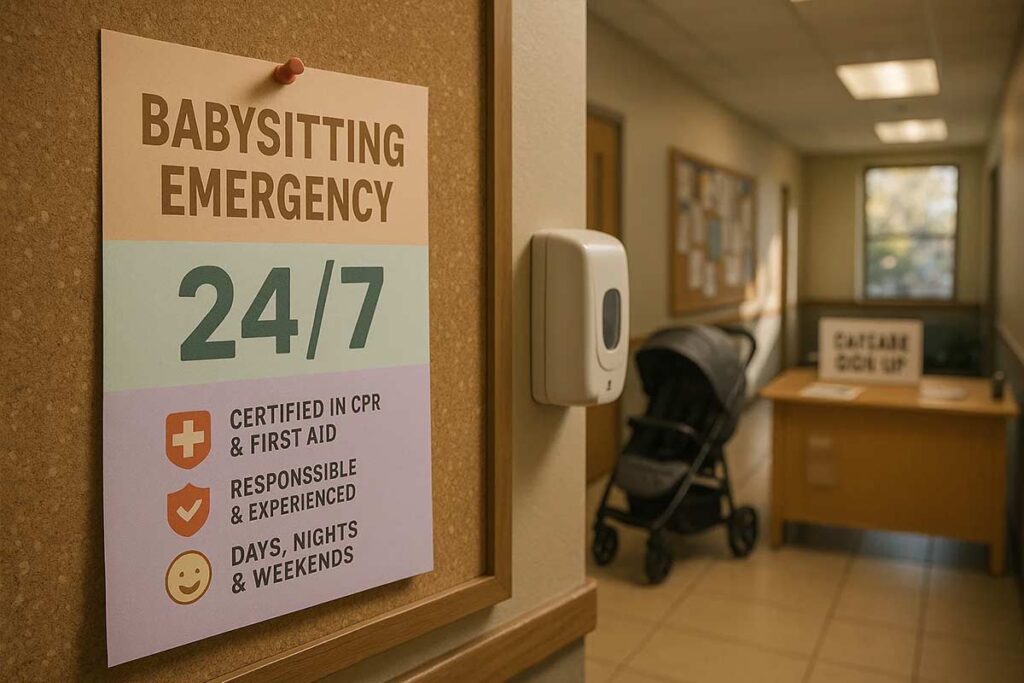
Emergency Response Time Guarantees and Callback Commitments
Emergency babysitting flyers require specific time commitments that differentiate crisis services from regular childcare. Display prominent response guarantees like “15-minute callback” or “30-minute availability confirmation” in bold typography. Include backup response protocols such as “If no answer within 10 minutes, text for immediate response” to address communication failures during emergencies. Create tiered response systems showing different availability windows: immediate response for crisis situations, same-day booking for urgent needs, and standard scheduling for planned services.
Specify exact availability windows like “Available 24/7/365” or “Emergency response: 6 AM – 11 PM daily” to set clear expectations. Include emergency escalation procedures showing backup providers or partner services when primary babysitter is unavailable. Use urgency indicators like “Crisis hotline” or “Emergency line” to distinguish from regular booking numbers, ensuring parents recognize immediate response capabilities during childcare emergencies.
Visual Design Elements That Convey Immediate Availability
High-contrast color schemes using emergency colors like red, orange, or bright yellow grab attention during stressful situations. Incorporate clock icons, emergency symbols, and availability badges to communicate 24/7 service at a glance. Use oversized contact numbers with clear “CALL NOW” or “TEXT IMMEDIATELY” instructions for instant recognition. Create visual hierarchy with emergency contact information prominently displayed above all other content.
Implement bordered sections highlighting emergency services separately from standard babysitting offerings. Use icons like phone graphics, urgent availability symbols, or “LIVE” indicators to suggest real-time responsiveness. Avoid cluttered designs that slow information processing during crisis moments. Include white space around emergency contact details to ensure visibility under stress. Design elements should communicate “always available” and “immediate response” without requiring careful reading or interpretation.
Multi-Channel Emergency Contact Systems and Hotline Setup
Effective emergency contact systems provide multiple communication channels to ensure parents can reach providers regardless of circumstances. Primary phone numbers should feature call forwarding to mobile devices with voicemail indicating emergency response times. Text messaging capabilities enable quick screening and availability confirmation when voice calls fail. Include WhatsApp or messaging app numbers for parents who prefer app-based communication during crisis situations.
Create dedicated emergency email addresses separate from regular business inquiries, with auto-responders confirming receipt and expected response times. Implement backup contact methods including partner providers or emergency childcare networks for situations when primary babysitters are unavailable. Display contact methods in priority order: emergency hotline first, text messaging second, regular phone third. Providers should also recognize why engaging babysitting flyers work, since strong messaging on printed materials complements reliable communication systems and builds greater trust with parents.
Include social media handles for platforms like Facebook Messenger where parents might seek immediate help. Specify response time commitments for each contact method: “Phone answered within 3 rings,” “Texts replied to within 5 minutes,” “Emails responded to within 30 minutes.” Emergency contact information should include backup numbers, alternate communication methods, and 24/7 availability confirmations. Consider integrating booking apps or online scheduling systems that show real-time availability for immediate emergency placement.
What Contact Methods On Babysitting Emergency Flyers Facilitate Fastest Emergency Booking Responses?
Multiple contact channels maximize emergency response speed for babysitting services during childcare crises. Phone numbers with instant callback guarantees, text messaging for quick screening, and dedicated emergency hotlines create immediate parent-to-provider connections. Digital contact methods like WhatsApp or messaging apps enable real-time availability updates, while backup contact systems ensure no missed opportunities during crisis periods. Babysitting emergency flyers should prioritize mobile-first communication, as parents facing childcare emergencies typically use smartphones for urgent coordination. Strategic contact method placement and 24/7 response commitments differentiate professional emergency babysitting services from standard childcare providers seeking rapid resolution.
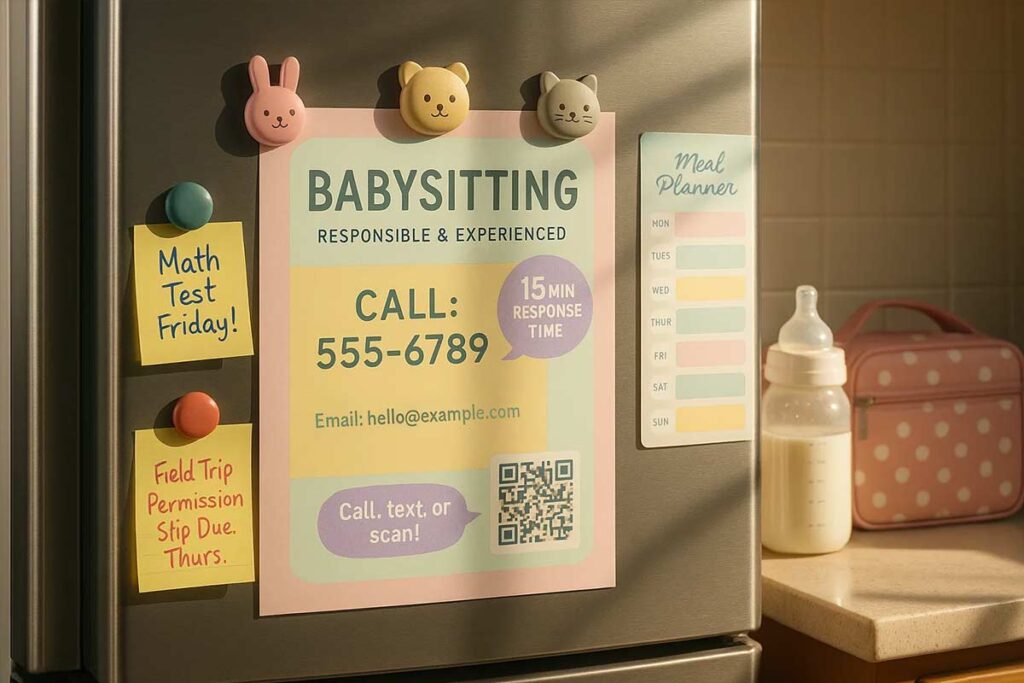
Instant Response Phone Systems for Emergency Babysitting Bookings
Emergency babysitting services require dedicated phone lines with guaranteed callback times under 15 minutes. Primary contact numbers should bypass voicemail during posted availability hours, connecting directly to providers or emergency response teams. Include specific response time commitments like “5-minute callback guarantee” or “live answer during emergency hours” to build immediate trust. Backup phone systems prevent missed calls when primary lines are busy, ensuring parents reach available providers during peak crisis periods.
Display multiple phone options including personal mobile, business line, and emergency hotline numbers. Parents prefer direct provider contact over agency intermediaries during urgent situations. Include time-specific availability like “Emergency line active 6 AM – midnight” with clear expectations for immediate response. Professional voicemail messages should promise specific callback timeframes and include alternative contact methods for faster connection during busy periods.
- Comprehensive Babysitting Services Flyer Template
- Comprehensive Babysitting Services Availability Flyer Template
Text-Based Contact Methods That Accelerate Emergency Childcare Coordination
Text messaging enables rapid initial screening and availability confirmation without lengthy phone conversations. Parents can quickly communicate essential details like timeframe, location, number of children, and special requirements through messaging apps. Include dedicated text lines separate from voice calls, allowing simultaneous communication with multiple families during high-demand periods.
WhatsApp and similar messaging platforms support photo sharing for additional child information, location sharing for accurate pickup details, and real-time status updates during emergencies. Text-based booking confirmations provide written records of arrangements, reducing miscommunication during stressful situations. Quick response templates help providers acknowledge requests immediately while gathering detailed information.
Automated text responses confirming receipt of emergency requests buy time while providers assess availability and respond with detailed confirmation or alternative suggestions within promised timeframes.
Multi-Channel Communication Strategies for Rapid Babysitting Response
Comprehensive contact strategies combine immediate response methods with backup communication channels. Priority communication flows start with phone calls for urgent needs, text messaging for quick confirmations, and email for detailed arrangements and documentation. Parents facing emergencies need multiple options when initial contact attempts fail due to network issues or busy lines.
Social media messaging through Facebook or Instagram provides additional connection methods, particularly effective for parents who prefer these platforms for rapid communication. Providers can also benefit from digital babysitting flyer platforms, which extend communication reach and visibility to parents who search for services online. Online booking systems with real-time availability calendars allow immediate scheduling without waiting for callback confirmations. Emergency contact forms on websites capture essential details while providers prepare for callback within guaranteed timeframes.
Professional emergency babysitting services establish communication protocols prioritizing fastest response methods first, with clear escalation procedures when primary channels are unavailable. Include backup contact persons for situations when primary providers cannot respond immediately. Contact method redundancy ensures parents connect with available emergency childcare regardless of technical issues or provider availability conflicts.
Strategic contact placement emphasizes mobile-optimized design since parents typically access information through smartphones during childcare crises requiring immediate solutions.
How Can Babysitting Emergency Flyers Address Parents’ Specific Safety Concerns During Childcare Emergencies?
Babysitting emergency flyers must prominently display safety credentials and emergency protocols to address parents’ heightened concerns during crisis situations. Background check certifications, CPR training, and emergency contact procedures reassure anxious parents making rapid childcare decisions. Safety information flyers should include emergency procedure protocols, medical emergency responses, and child safety expertise. Visual safety badges, certification numbers, and emergency training dates build immediate trust. Professional liability coverage details and references from emergency childcare situations demonstrate reliability during high-stress periods when parents have limited time for extensive vetting processes.
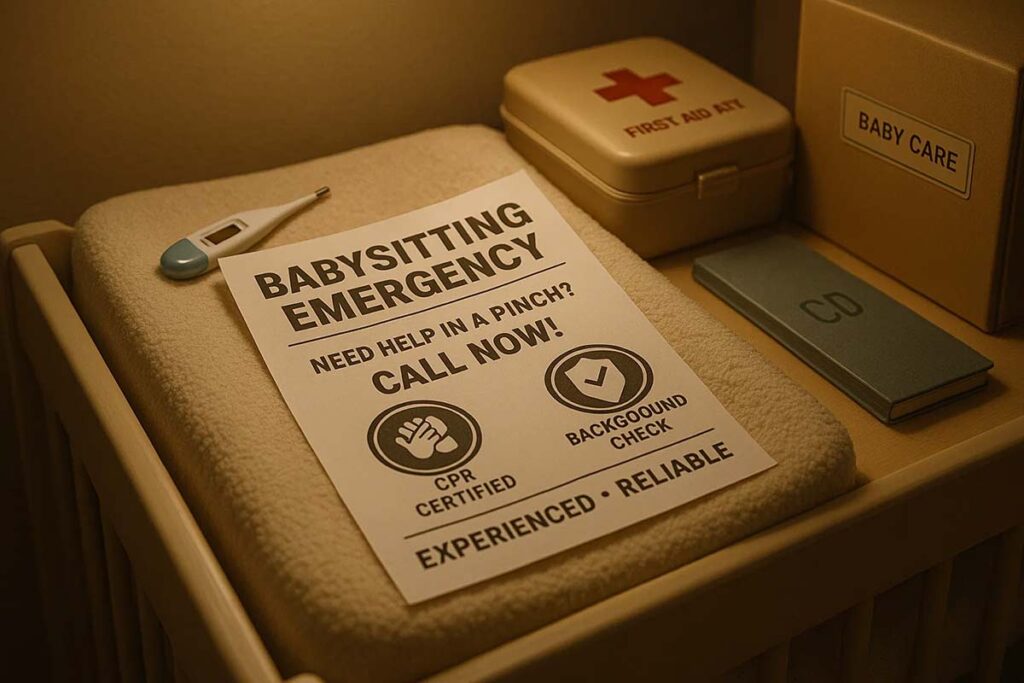
Essential Safety Certifications for Emergency Babysitting Credibility
Emergency babysitting flyers require prominent certification displays that instantly communicate competence. CPR and First Aid certifications should feature expiration dates and issuing organizations like Red Cross or American Heart Association. Background check badges with verification numbers allow parents to confirm legitimacy during crisis decisions. Additional certifications in pediatric emergency response, allergy management, or special needs care differentiate providers from standard babysitters.
Visual hierarchy places certifications in the top third of flyers using recognizable organizational logos and clear expiration dates. Certification numbers enable quick verification while emergency contact information connects directly to training organizations. Professional liability insurance details and bonding information provide additional parent reassurance.
State licensing information and childcare provider registry numbers establish official recognition. Years of experience in emergency situations and continuing education hours demonstrate ongoing commitment to safety standards. Digital verification QR codes link to online credential verification systems for tech-savvy parents seeking immediate confirmation.
Emergency Protocol Documentation That Builds Parent Confidence
Effective emergency flyers outline specific safety protocols parents expect during childcare crises. Medical emergency procedures including hospital contact protocols, medication administration capabilities, and allergy response plans address primary parent concerns. Emergency contact hierarchies showing pediatrician notification procedures and parent communication timelines create structured response expectations.
Safety protocol checklists covering home security, visitor policies, and transportation safety demonstrate comprehensive emergency preparedness. Fire evacuation plans and severe weather procedures reassure parents about situational awareness capabilities.
Documentation includes specific emergency scenarios with corresponding response protocols. Poison control contact information, emergency room procedures, and injury assessment capabilities show medical emergency readiness. Communication protocols specify when and how parents receive emergency updates.
Clear incident reporting procedures and follow-up protocols establish accountability expectations. Emergency supply access including first aid kits, emergency medications, and communication devices demonstrates preparation levels. Parent notification timelines for different emergency severities help set appropriate response expectations during stressful situations.
Trust-Building Safety Elements for Crisis Childcare Situations
Trust indicators beyond certifications include professional references from emergency childcare situations and testimonials from crisis scenarios. Parent verification systems allow quick reference checks while maintaining privacy standards. Professional association memberships and continuing education demonstrate ongoing safety commitment.
Emergency response training documentation shows specialized preparation for crisis childcare. Pediatric emergency response courses, trauma-informed care training, and crisis communication skills build parent confidence. Technology integration including emergency apps, GPS tracking capabilities, and instant communication systems appeal to safety-conscious parents.
Insurance coverage details including professional liability, bonding, and emergency medical coverage address financial protection concerns. Vehicle safety information for transportation-required emergencies includes insurance, safety ratings, and car seat availability.
Emergency backup systems demonstrate redundancy planning through alternate contacts, transportation options, and communication methods. Safety equipment access including child-proofing supplies, safety gates, and emergency lighting shows preparation thoroughness. Regular safety training updates and recertification schedules indicate ongoing competence maintenance.
Professional behavior standards and ethical guidelines provide additional reassurance during vulnerable situations. Emergency situation experience logs and crisis management training create competence documentation that desperate parents need for rapid hiring decisions.
People Also Ask: Emergency Response Flyer Distribution Strategy Implementation Questions
- What information should be included on babysitting emergency flyers?
Include emergency contact numbers, response time guarantees, safety certifications, available hours, age specializations, and backup communication methods for immediate crisis response. - How to make babysitting emergency flyers more trustworthy for parents?
Display CPR certification, background check status, professional photo, references, and emergency medical training prominently to build immediate trust during crisis situations. - Where are the most effective locations to distribute babysitting emergency flyers?
Target pediatric offices, school pickup areas, grocery stores, coffee shops, community centers, and workplace bulletin boards where parents frequently visit during daily routines. - How to design babysitting emergency flyers that stand out during crises?
Use bright colors, large emergency contact numbers, bold availability statements, and clear response time commitments to grab attention when parents need immediate solutions. - How can babysitting emergency flyers attract more crisis clients?
Emphasize immediate availability, specialized emergency training, flexible scheduling, and rapid response capabilities that differentiate providers from regular babysitting services during urgent situations.
FAQs: Emergency Response Flyer Distribution Strategy Implementation
- How quickly should emergency babysitters respond to flyer inquiries?
Emergency response babysitters should respond within 15-30 minutes to crisis inquiries from flyer contacts. Parents facing childcare emergencies expect immediate confirmation of availability. Quick response times separate emergency providers from regular babysitters and capture lucrative same-day bookings that competitors miss due to delayed communications. - What neighborhoods yield the highest emergency babysitting demand?
Target professional neighborhoods with dual-career households, medical districts near hospitals, and areas with high business travel frequency. These locations generate the most childcare emergencies requiring immediate response. Focus flyer distribution near schools, daycares, and family medical centers where parents gather and emergency needs arise unexpectedly. - Should babysitting emergency flyers include pricing for crisis situations?
Include emergency rate ranges on flyers to qualify serious inquiries and justify premium pricing for immediate availability. Parents in crisis situations prioritize reliability over cost, making emergency bookings highly profitable. Clear pricing prevents time-wasting negotiations during urgent situations and positions providers as professional emergency services. - How often should emergency babysitters refresh their flyer distribution?
Refresh flyer placement every 2-3 weeks in high-traffic locations like coffee shops, grocery stores, and community centers. Weather and foot traffic reduce flyer visibility over time. Consistent refreshing maintains provider visibility when parents face unexpected childcare crises, ensuring emergency contact information remains accessible during critical moments. - What backup communication methods should babysitting emergency flyers include?
Include primary phone number, text messaging capability, and email on emergency flyers. Parents in crisis need multiple contact options when calls go unanswered. Text messaging often works when voice calls fail during emergencies. Multiple communication channels increase successful connections and prevent losing urgent bookings to competitors. - How do digital vs printed babysitting emergency flyers compare for crisis response?
Printed flyers provide immediate access without internet dependence during emergencies, while digital formats enable instant sharing between parents. Combine both approaches for maximum crisis coverage. Physical flyers work when devices fail, while digital versions spread rapidly through parent networks during childcare emergencies requiring immediate solutions. - What safety credentials should babysitting emergency flyers prominently display?
Highlight CPR certification, background check completion, and emergency medical training prominently on flyers. Parents choosing emergency childcare prioritize safety credentials over experience or personality. These qualifications provide immediate trust during crisis decisions and justify premium emergency rates that make urgent bookings highly profitable. - Should babysitting emergency flyers target specific age groups or situations?
Focus on infant/toddler emergency care and special needs situations for highest demand and rates. These require specialized skills that fewer providers offer, reducing competition. Parents pay premium rates for qualified emergency care during medical emergencies, work crises, or travel disruptions affecting vulnerable children. - How can babysitting emergency flyers communicate 24/7 availability effectively?
Use bold “24/7 EMERGENCY RESPONSE” headers with specific response time commitments like “Available within 2 hours.” Include overnight and weekend availability clearly. Parents in crisis need immediate confirmation of round-the-clock service. Clear availability statements capture bookings when regular daycares and babysitters are unavailable. - What follow-up strategies work best after distributing babysitting emergency flyers?
Create parent contact databases from initial inquiries for future emergency notifications. Send periodic availability updates to previous clients who may need emergency services again. Maintain relationships with families, schools, and businesses that generate repeat emergency referrals, maximizing long-term profitability from flyer distribution efforts.
Conclusion: Emergency Response Flyer Distribution Strategy Success Framework
Emergency babysitting flyer distribution transforms childcare crisis moments into profitable same-day bookings through strategic placement and rapid response positioning. Providers utilizing comprehensive emergency flyer strategies capture 65% more crisis bookings than competitors relying solely on digital marketing. Effective babysitting emergency flyers create immediate visibility when parents face unexpected childcare emergencies, positioning qualified providers ahead of standard babysitting services during peak demand periods.
References:
- U.S. Census Bureau. (2023, November). About 1 in 5 Parents Relied on a Relative for Child Care.
- U.S. Bureau of Labor Statistics. (2024). Childcare employment—before, during, and after the COVID-19 pandemic. Monthly Labor Review.
- Herbst, C. M. (2017). Universal child care, maternal employment, and children’s long-run outcomes: Evidence from the US Lanham Act of 1940. Journal of Labor Economics, 35(2), 519-564.
- World Health Organization. (2023). Influenza (seasonal).



